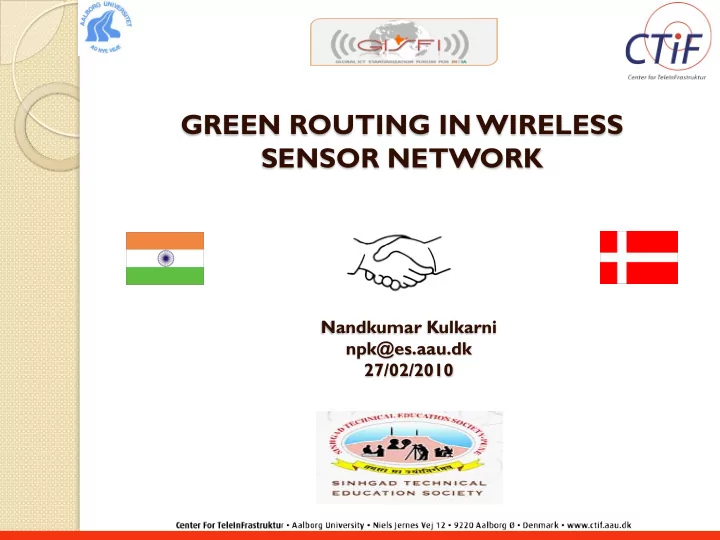

GREEN ROUTING IN WIRELESS SENSOR NETWORK Nandkumar Kulkarni npk@es.aau.dk 27/02/2010
Supervisors Supervisor Prof. Ramjee Prasad CTiF, AAU, Denmark Co-Supervisor Co-Supervisor Assoc. Prof. Horia Cornean Prof. Mrs. Nisha Gupta AAU, Denmark BIT, Mesra, Ranchi, India
Outline Background Routing challenges and design issues Routing Protocols in WSNs Research Goal Milestones Questions 2/9/2010
Background Sensor Node Components • Sensor Unit • Radio Unit, • processing Unit • Battery Unit. Sources of Energy Consumption ◦ Communications (Transmitting & Receiving) ◦ Computations ◦ Sensing space and cost constraints Not feasible to recharge or change batteries on a regular basis 2/9/2010
Routing Challenges and Design Issues Network dynamics ◦ Mobile nodes ◦ Mobile events – static / dynamic Node deployment ◦ Manual deployment ◦ Random deployment Energy Consideration ◦ Direct Routing ◦ Multihop Routing 2/9/2010
Routing Challenges and Design Issues (contd…) Fault tolerance ◦ Failure of sensor Node Capabilities ◦ Homogenous / Heterogeneous Sensor Nodes Data Delivery Model ◦ Continuous ◦ Event driven ◦ Query driven ◦ Hybrid 2/9/2010
Routing Protocols in WSNs Data Centric Hierarchical Location-based 2/9/2010
Routing Protocols in WSNs (contd..) Routing Classification Power Data Scala Query Over Data delivery Protocols Usage Aggregation bility Based head model SPIN Data-centric Ltd. Yes Ltd Yes Low Event driven DD Data-centric Ltd Yes Ltd Yes Low Demand driven RR Data-centric Low Yes Good Yes Low Demand driven GBR Data-centric Low Yes Ltd Yes Low Hybrid ACQUIRE Data-centric Low Yes Ltd Yes Low Complex query LEACH Hierarchical High Yes Good No High Event driven TEEN & Hierarchical High Yes Good No High Event driven APTEEN PEGASIS Hierarchical Max No Good No Low Event driven GAF Location Ltd No Good No Mod Demand driven GEAR Location Ltd No Ltd No Mod Demand driven 2/9/2010
House of IoT 2/9/2010
Research Goal The research goal is ◦ To develop fault tolerant , energy efficient, multihop routing strategy for Quasi Random deployment of the sensor nodes to transfer sensor data for the purpose of maximizing the lifetime of WSNs. ◦ Framework will be designed for integrating WSN into the “Internet of Things”, where sensor nodes join the Internet dynamically, and use it to collaborate and accomplish their tasks. 2/9/2010
Milestones Design of the framework Implementation Simulation Performance Analysis and Optimization 2/9/2010
Questions? 2/9/2010
Recommend
More recommend